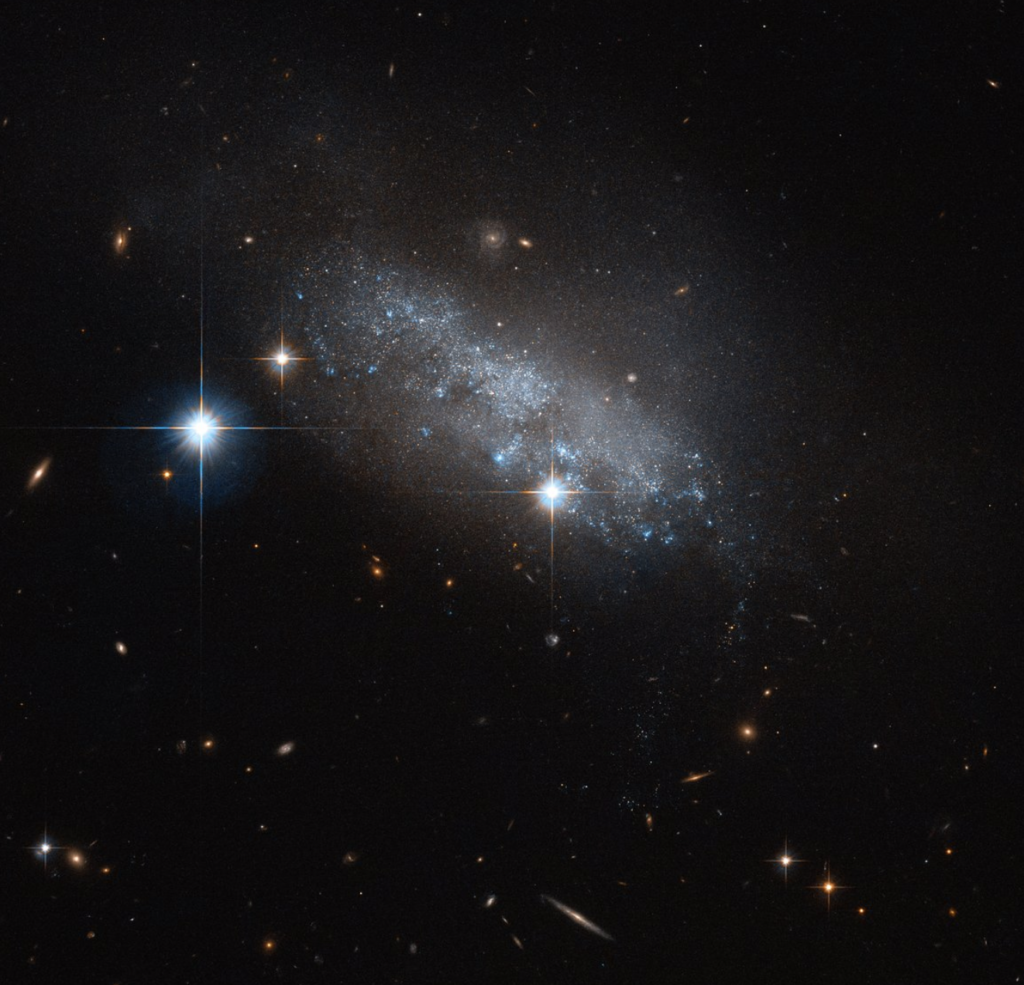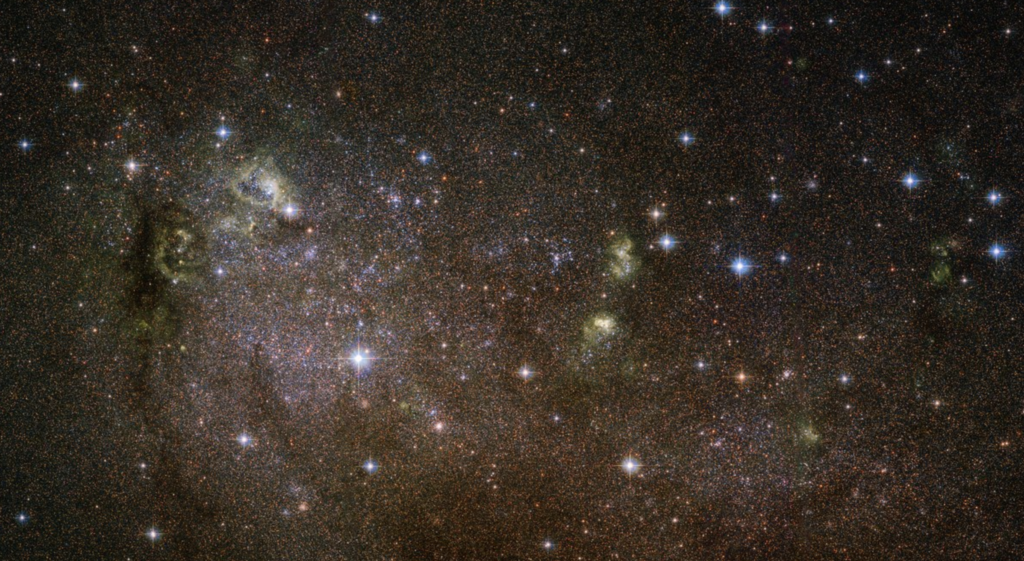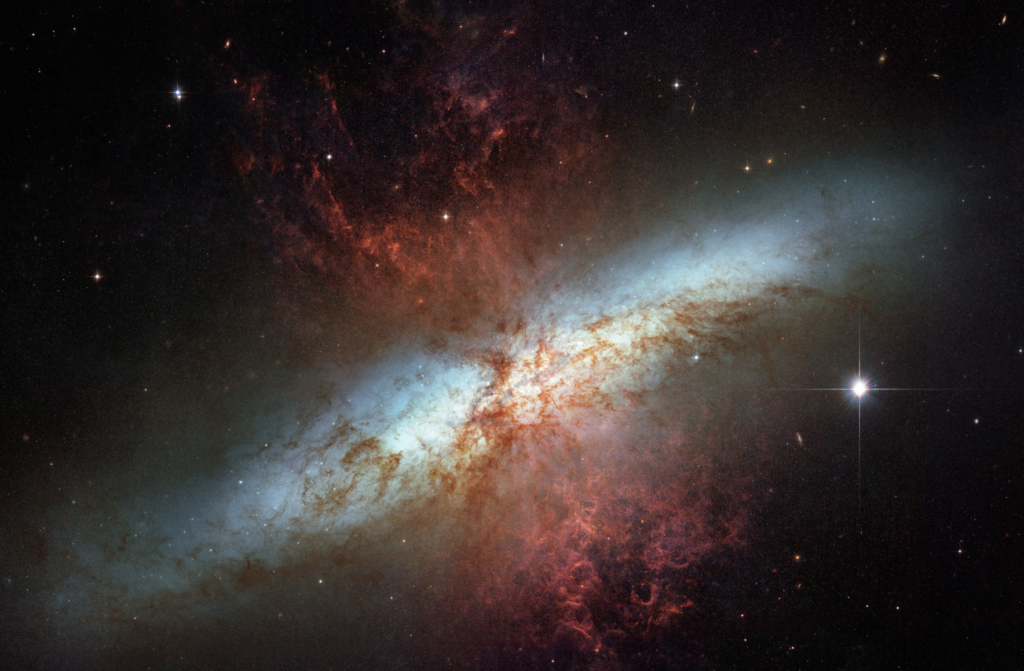Irregular Galaxy: A Unique Collections of Stars
A Reflection Nebula is a gigantic cloud of dust and gas in the vast openness of space between stars. A reflection nebula doesn’t produce light; instead, it reflects the light of nearby stars. Nebulae are highly photogenic, so you’ve likely seen pictures of them even if you didn’t realize it.
An irregular galaxy is unique in its age and shape. It’s neither spiral nor elliptical and exists in the middle of its life span as a galaxy.
Table of Contents

What Is a Nebula?
A Nebula is gigantic cold clouds consisting of dust and ionized gasses like hydrogen and helium. Sometimes the clouds form in the chaotic aftermath of a dying star’s explosion. Other nebulae act as star nurseries, becoming the region where new stars are born.
In 964, a Persian astronomer noted “a little cloud” near the Andromeda Galaxy. That’s when Abd al-Rahman al-Sufi made the first reference to what scientists later called a nebula.
The Latin word nebula means cloudy or misty. Nebula was a medical term in the 1300s referring to urine cloudiness or an eye film causing blurriness and vision problems. In the 1600s, astronomers began using the word to describe interstellar gas and dust clouds.
What Is a Galaxy?
NASA defines a galaxy as a “huge collection of gas, dust, and billions of stars and their solar systems, all held together by gravity.”
In 1995, the Hubble Space Telescope focused on a small part of space for ten days to better understand galaxy density. Scientists focused their search on a dark area near Ursa Major, near the Big Dipper’s Handle.
Imagine holding a straight pin out at the length of your arm. Now, imagine counting approximately 10,000 galaxies on the tip of that pin! That’s essentially what these scientists did using the Hubble scope.
What Makes an Irregular Galaxy?
Galaxies lacking structure and defying classification gain irregular status. For example, they lack central bulges of the elliptic and the pinwheel-like arms of spiral galaxies.
Although we see revisions to Edwin Hubble’s initial 1926 galaxy classifications, many of his original designations stand today.
Scientists consider galaxy life starting as spiral shapes. As they age and collide with other systems, galaxies become irregular. Finally, in their later years, galaxies consume the gases from which they form stars before shifting into older, elliptical forms.

Galaxy Shapes
The Earth resides in a solar system within the spiral Milky Way Galaxy, which has curved pinwheel-like arms. Other galaxies coalesce into elongated spiral shapes earning the name elliptical.
Other galaxies do not conform to natural contours. These are called irregular galaxies. Neighbors of galaxies influence their shapes as they collide or interact. Uneven gravitational forces of these interactions push and pull the galaxies, further distorting their bodies.
- Irr-I classified galaxies have some shape but need less distortion and more structure to gain spiral or elliptical classifications.
- Irr-II galaxies are chaotic with no discernible structure.
Galaxy Ages
Many of these non-conforming galaxies are in their teenage years of maturity. While there are exceptions to the rule, as mentioned below, most of these irregular galaxies have young stars in their midst.
Of course, young is a relative term since young stars are 20-30 million years old. In addition, dwarf irregular galaxies have a lower percentage of heavy elements than the Sun.
Irregular Galaxy Composition
Irregular galaxies are small, sometimes dwarf, full of dust and gas. Since they have few heavy elements, star formation runs rampant within them. As a result, irregular galaxies are often extremely bright.
Dwarf irregular galaxies mainly give insight into early universe galaxies as they hold similar cosmic properties of high gas levels with low metallicity levels. Scientists better understand Milky Way formation by studying irregular galaxies.
Irregular Galaxy Examples
Only about 20% of all galaxies have an irregular classification.
The Magellanic Clouds
The Magellanic Clouds consist of Large (LMC) and Small (SMC) irregular galaxies. The Magellanic Clouds reside between 16,000 and 200,000 light-years from Earth. They were the closest known galaxies to the Milky Way until the discovery of Sagittarius (see below) and Canas Major dwarfs.
Small Magellanic Cloud
The Small Magellanic Cloud sports a gas tidal tail called the Magellanic Stream. The gas stream shows a leading and trailing arm that’s only visible with radio wavelengths. The gas tidal tail extends almost halfway around the Milky Way.
Large Magellanic Cloud
The Large Magellanic Cloud resembles a volcano’s fiery innards with its cosmic glob of stars, dust, and gases. It has dark orange plumes of murky dust and red and green plumes of colder dust.
Star Formation
The galaxy’s white and blue areas reveal where stars form. The stars heat the very gases that are creating them. The new stars push hot solar winds around the galaxy for a fiery starburst show of young and old stars.
Scientists think the stream formed hundreds of millions of years ago after some type of interaction or collision with the Milky Way or the Large Magellanic Cloud.
By studying these irregular galaxies, scientists learn how stars form, evolve and die inside other galaxies. Additionally, they gain insight by comparing the galaxy’s magnetic field structure and interstellar dust distribution to that of the Milky Way.
Messier 82
Look to the skies near the constellation Ursa Major (the Great Bear) to see the Cigar Galaxy.
M82 is visible with high-powered binoculars. Best viewed in April and early Spring, M82 presents as a patch of light residing about 12 million light-years away from Earth. While you can see this galaxy with binoculars, M82 appears most glorious in compiled Hubble images.
This irregular galaxy produces heavy amounts of star births in its central region, a starburst. M-82 creates stars about ten times faster than the Milky Way. The new stars bond together, creating bright “starburst clumps.”
This active and turbulent galaxy was discovered by German astronomer Johann Elert Bode 1774.

Sagittarius Dwarf Irregular Galaxy (SagDIG)
Sagittarius is a tiny dwarf irregular galaxy lacking too many elements with atomic weights heavier than helium. While (sometimes) young galaxies have few heaier elements, in this case, scientists proved that this tiny star system is ancient. The majority of the elements heavier than helium were consumed during the formation of the galaxy itself.
SagDIG resides about 3.5 million light-years from Earth. Although some of its stars are young, astronomers concluded that the irregular galaxy is almost as old as the universe.
NGC 55
At a distance of 5-6 million light-years, NGC 55 lies within The Sculptor Galaxy Group. This irregular galaxy spans 50,000 light-years with a flattened and narrow profile.
It still produces new stars, as is witnessed by its pink areas. Astronomers see younger blue star groups in NGC 55.
Conclusion
An irregular galaxy forms when larger neighboring galaxies have stronger gravitational forces than the smaller existing galaxies. The pushing and pulling distort the smaller galaxy, causing it to lose more of its already irregular shape.
Irregular galaxies often have starburst centers that produce millions of stars until exhausting their gas resources. Scientists better understand the Milky Way’s formation when studying these irregular galaxy life cycles. While they represent only about 20% of all galaxies, these chaotic irregulars have much to teach.
